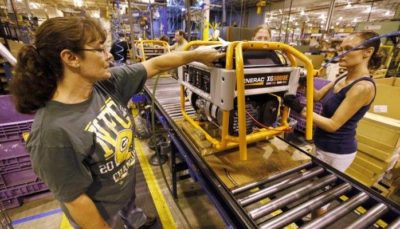 January marked 100 straight months with positive job growth. The unemployment rate is near an all-time low at 4.0%. There are more job openings than people to fill them. The president touts an “economic miracle.” But for many workers and employers, that miracle is a mirage.
January marked 100 straight months with positive job growth. The unemployment rate is near an all-time low at 4.0%. There are more job openings than people to fill them. The president touts an “economic miracle.” But for many workers and employers, that miracle is a mirage.
Recently, The Guardian published “Why record job growth in America hides a troubling reality.” It caught our attention because at the National Fund for Workforce Solutions, we know all too well the reality facing workers and employers—they’re struggling.
While it’s true that jobs are plentiful (a record 7.1 million openings, according to a new report) employers are offering primarily low-wage jobs (which may or may not be low-skill) or high-skill, high-wage jobs. The hollowing out of the middle class—the disappearance of mid-skill jobs with good, family-sustaining wages—has made long-term career growth and mobility difficult for many workers.
In other words, the economy may be humming along, but workers are reaping little of the economic gains of this recovery.
At the same time, employers are struggling to find and keep top talent in this labor market. Of course, with so many positions available, workers can be selective. After the passage of the Tax Cuts and Jobs Act in late 2017, the National Fund urged employers to #InvestYourCut in long-term infrastructure, training, and other things that benefit workers. Then, as now, however, employers are relying on bonuses and other one-off incentives to recruit talent. The Guardian, for example, mentions a business that is offering new employees premium cable TV sports packages.
We are glad to see more journalists digging beneath the top-line employment numbers that are always reported; however, even The Guardian fails to get at the foundational issues of the current labor dynamic: offering a nice cable package to new employees is a great marketing recruitment tool, but what happens next? Workers want good jobs that allow them to earn a living wage and grow their career. They want to work at an organization where their work and contributions are valued.
At the National Fund, we’re working with employers to move in a new direction. We’ve created a job design framework, a tool for employers to develop and design good jobs for their workers—and ideally in collaboration with their workers. This framework prompts employers to consider what about a job is most valuable to potential employees and put together a selection of elements—everything from wages to stable schedules to peer mentors to transportation vouchers—to build a good job that is tailored to that business environment.
A good job is a competitive advantage—workers who feel valued become partners in growing the business. Organizations that prioritize their workers as an asset to be maximized, rather than a cost to be limited, have a leg up in today’s tight labor market.





